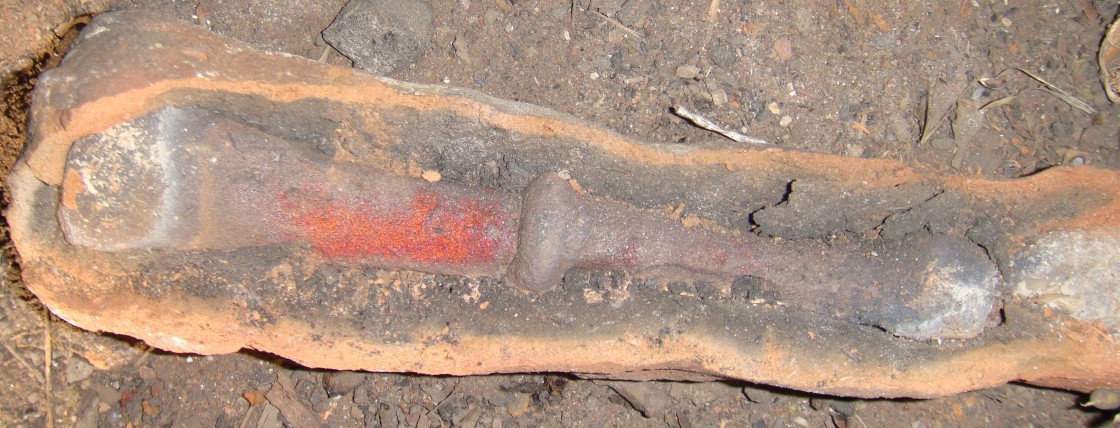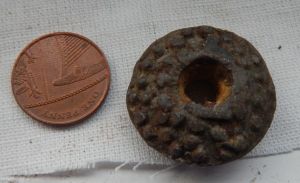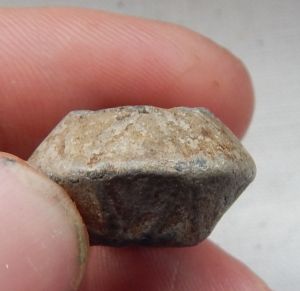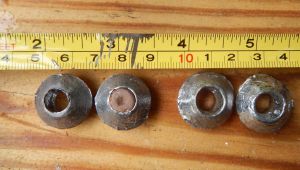For several years now I have been trying to make various replica pewter and lead objects, one being a spindle whorl. Not perfect copies cast from an original in silicone, but copies of the sort that a foundryman might make after seeing an object. Of course the process of making the object can also teach you something about the manufacturing capabilities of the time and confirm or disprove how you think it was made.
Spindle whorls are the weight which keep the spindle turning when you are using a drop spindle to make thread, as was common throughout the medieval period and into the 17th century. Excavated examples include ones made of wood, pottery and lead and obviously I am interested in the latter.
Of course nobody seems to have written anything about how they were made, except it is obvious that they were cast. I have examined 5 myself, and the portable finds database gives access to photographs of many others, of several main types amongst the hundreds of examples.
E.g. :
https://finds.org.uk/database/artefacts/record/id/730362
The PAS finds 1,737 medieval lead spindle whorls, which is probably a small fraction of those found over the years, nevertheless it indicates a huge number of them.
Unfortunately the first attempt I made 5 years ago now involved casting plaster and a spindle whorl:
It didn’t really work, casting plaster is trickier to use than you think, especially when the whorl is of such an odd shape.
A friend lent me a smaller simpler whorl several years ago, and I’ve been carving since then.
This is it side and top view. Note how well rounded it is, which might be due to wear or the method of casting:
So I tried again with a stone mould, and it has taken a couple of years of work, on and off, to get it to the proper useful stage. Here it is, both sides.
The usual soapstone mould, and it has been a useful learning experience. The first part carved was that at the top left and top right, with the bit sticking up. I poured the metal straight in the top in the wide ingate you can see. However the early test casts ended up with an air bubble at the top of the whorl by the ingate. This is because the air had no way of getting out. Unsurprisingly, real surviving moulds often have the metal coming in from the side of the mould, letting the air out by vents at the top. So I changed the mould to make the metal come in from the bottom, and added more air vents, pretty much eliminating the air bubbles.
It turned out that the centre hole is difficult to make. Because the whorl has to be pulled off the stone mould, the centre stone has to taper slightly, which means the inside of the whorl is not so straight, yet it is in the real ones I have looked at, or straight enough. Even worse, this all means that it tapers towards the inside of the mould from both sides, meaning there is a ridge of metal around the inside of the mould. Not something that I have seen in the originals.
So the solution is to make a central core that is straight up and down. One option is to use sand and clay to make it, another to carve a round piece of soapstone to fit within the mould. Unfortunately all I have tried so far is with the clay and sand mixture, and here are the results:
The features of the castings are not so different from the original and the weight is near enough.
I have come to the conclusion after all this that the best way to get nearly identical whorls is by means of a mould like a finger ring mould such as the roughly late 14th century one from Perth. You can clearly see the ingates and the way that the 2 part mould fits together with a central tapering core that is removable. I am convinced that this is how the spindle whorls were made, as being the easiest method that will most closely match the actual finds. This would also explain the very rounded nature of the equator rim of the spindle whorl, as compared to the sharp ones on those I made. Now to cut up some stone and start again.
Perth finger ring moulds, photographed in the “Medieval Scotland” book by Peter Yeoman:










Hi Guthrie,
I’m astonished by the mould with the two integral columns. That is (literally) hard core.
I’ve been toying with the idea of spindle whorls for a while now, and this prompted me to get on with it. I think the solution is to use a Straight wooden former in a hole through the mould at 90º to the mould face. This allows you to put in the kind of detailing seen on the originals without the piece locking into the mould, astray would do if you used a former parallel to the face as in the Ring moulds.
Anyhow, this mornings adventure in hot metal and stone,
http://pbsn3.pbworks.com/w/page/106138593/Spindle%20Whorl
I’m glad to see you are dressing your stone a bit more carefully. Having the mould all squared up makes things infinitely easier.
Cheers
Dan
LikeLike
Re. the internal columns, some things seem like an interesting idea at the start, and then you get 80% of the way through and realise that it isn’t going to work as well as the methods they used.
But then I do like getting negative results as well, in order to eliminate possibilities and give examples which you can they say “The originals don’t look like this, so can’t really have been made that way”.
What do you mean it took you 2 hours? I’m jealous….
I think I’ll give your way a go before maybe trying to ring method.
LikeLike
I mean it took me two hours from picking up a piece of stone, making one false start, starting again, to the point of “Cool that works.” 🙂
Practice grasshopper….
LikeLike
Do either of you sell your work? I’ve been looking for some repro whorls for reenactment and casting isn’t in my skillset
LikeLike
I don’t know about Dan, but all I’ve sold so far are some buckles. I’ll put more effort into selling things when I’m confident that I can make something that is accurate and useful. So if you want some pewter belt studs I have 2 or 3 designs that are ready to sell and I’ve stuck some on my own belt.
LikeLike
Hi Amy,
I do the occasional commissioned piece. Drop me a line.
LikeLike
Thanks Dan, I’ll message you via facebook, you’re in reenactors trade and sale, aren’t you? (just so i don’t message some random)
LikeLike
Hi, I have several original lead whorls but the most fascinating is the half whorl with a splodge of lead coming form it, it looks like a mould had broken and lead spilt out. This is the reason why I thought they might have been made in two parts and joined by heat afterwords? is that a possibility?
Your reproductions are brilliant by the way.
LikeLike
I’m afraid joining them by soldeirng would be fiddly and difficult, far easier to cast them in once piece. Do you have a photo of your whorl with the bit of lead on it, maybe it was left that way from casting? It could be a sprue or as you say a bad mould.
LikeLike
Hi Susan, Do you have a picture of that Half whorl?
It sounds to me like a test piece from the mould making process.
i produce them all the time, but they usually go back in the melting pot.
LikeLike